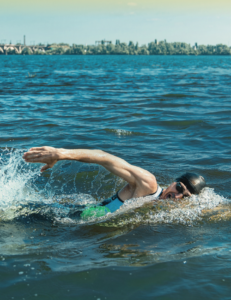Elevate your triathlon training with brick workouts! Uncover the importance of combining disciplines, enhancing endurance, and building mental resilience. Explore dynamic workout ideas to conquer race-day challenges.
Tag Archive for: swimming
Beat the heat while prepping for Kerrville Tri! Dive into our blog for refreshing swim workouts with a kickboard, designed for triathletes. Boost technique, endurance, and performance in the water. Let’s make a splash!
Kerrville, Texas, boasts a delectable culinary landscape that caters to all tastes and cravings. Indulge in a cozy and charming meal at Bridget’s Basket or savor the fine dining experience at Pinnacle Grill. For a true taste of the region, Hill Country Cafe offers comfort food with a local twist.
One of the first decisions you’ll need to make when doing a triathlon is what type of suit to wear. Do you go for a one-piece or two-piece? There are pros and cons to both options, so it’s important to weigh up all the factors before making your decision. In this blog post, we’ll take a look at some of the key differences between one-piece and two-piece suits, as well as the advantages and disadvantages of each option. So read on if you want to find out more!
What is a Tri Suit?

A tri suit is a garment designed specifically for triathletes to be worn during the swim, bike, and run. They are made of a swimsuit-like material that dries quickly during your transition to the bike. They also make riding more comfortable with built-in pads that you won’t even notice during the run. It usually has built-in pockets so that you can carry some nutrition with you as well.
Most importantly, the suit allows for a total range of movement so you can wear the suit for the entire tri. A tri suit is an element of the basic triathlon gear you need, so keep reading to understand the differences between a one-piece and two-piece tri suit.
Two-Piece Tri Suit
A two-piece tri suit is a set of tri shorts and a tri top. Some athletes prefer a two-piece because they offer a few advantages.

For example, a two-piece is less likely to restrict your range of motion from being too tight on your shoulders and allow for natural movement. The two-piece suit also tends to feel cooler than a one-piece, due to the fact your mid-drift can be exposed.
A two-piece suit is also great for athletes who may require different-sized clothing for the upper and lower parts of their body. You can also usually find more options for the length of shorts. For women, you can find inseams from anywhere from 5 inch to 8 inch. Many prefer a shorter short length for short distances or training while a longer length can help prevent chaffing on longer distances.
One drawback is the two-piece can be less aerodynamic during the bike portion if the suit bunches up. Leaning too far forward on your bike can also cause the back of your tri top to rise up and lead to exposed skin. This is not ideal to protect your skin if you were to fall on the bike course or raise the risk of getting a sunburn.
One-Piece Tri-Suit
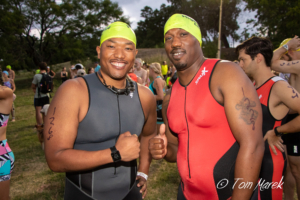
One-piece tri suits are more commonly preferred by most athletes for simplicity. A one-piece suit typically has some compression built-in, making the suit more aerodynamic for athletes who opt for a one-piece. Athletes also say there’s less chafing with a one-piece because there are fewer seams in the suit.
Many prefer a one-piece because you don’t have to worry about your shirt riding up or your shorts moving down exposing your mid-drift. Less shifting around = more time saved and a more comfortable experience.
Lastly, a one-piece suit is a better option if you will be wearing a wet suit during your race again because you don’t have to worry about anything moving where it shouldn’t when you go to peel off your wetsuit.

One drawback of a one-piece suit is the material the suit is made of can cause you to feel warmer throughout the race. This is important to take this into account depending on which tri distance you complete and what time of year your race takes place. You can look for a one piece that has a zipper for venting if needed. The other drawback is that you have to find a suit that works with your torso length, finding your “dream” suit can take longer with more trial and error.
At the end of the day, comfort is most important when choosing the best tri suit for you, if you decide to wear one at all. Hopefully, now you have the knowledge and tools you need to get yourself the perfect suit for your upcoming tri!
Learn the benefits and safety tips of swimming in cold water
Swimming in cold water is an exhilarating experience. It’s a fantastic way to get fit, unwind, and strengthen both your mind and body. Swimming laps in chilly water can wake you up and make you feel alive in a way that no warm swimming pool can. For triathletes, cold, open water swimming is a vital part of training. It can provide you with more space and fewer swimmers since everyone won’t flock to the cold swimming areas. Learn why taking an icy dip can be good for you and how to accomplish it safely.
Benefits of Swimming in Cold Water
-
Increased stress tolerance
Swimming in cold water is scientifically documented to improve psychological markers of stress tolerance. The shock and adaptation you experience make your body thrive under stress in the long run, not just tolerate it. Swimming in cold water increases the adaption even more. Just like any other physical activity, it’s an excellent method to relieve stress.
-
Improved circulation
Coldwater imposes vasoconstriction on your blood vessels, followed by a period of compensatory vasodilation. This forces your body to warm your core when you enter the cold water. It then creates a dilation when blood rushes to your extremities to warm them up again. This process of alternation between constriction and dilation dramatically improves overall circulation.
-
Superior calorie burn
Swimming against cold waters forces your body to thermoregulate more than usual while you focus your mind and body on the difficult task of swimming. It also improves fat metabolization which makes you leaner and healthier in the long run. Swimming is considered a complete workout because you’re using every part of your body.
Follow These Safety Tips
-
Start small
Gradually immerse yourself in the chilly waters to begin. You can practice at home by slowly increasing the amount of cold water in your shower. It will be difficult to control your breathing initially, but continued training can reduce the amount of time you need to adjust to the cold. When building workouts, begin with shorter distances. This allows your body to acclimate to the temperature and adjust your breathing technique. Lastly, explore these helpful tips for taking your swim from the pool to the open water.
-
Don’t swim alone
Find your local swimming groups and participate in group swims. Swim partners can provide valuable feedback on your swim style, your kick, and your breathing that can lead to improvements. Partner swimming also provides an extra pair of eyes in case something goes wrong. And, don’t forget about the accountability factor. Knowing your friend or group is meeting you for a workout increases the likelihood that you show up too.
-
Wear a wetsuit
A wetsuit retains body heat and allows you to focus on the mechanical aspects of swimming first. It also helps to minimize the impact of cold water. You can then focus on your form, sighting, kicking, and breathing in the water. You could eventually graduate to wearing wetsuit shorts.
What You Need to Get Started
- gym bag to carry all your gear
- towel
- wetsuit
- swim goggles
- extra clothes for after your swim
Swimming in cold water is possibly one of the most challenging feats a triathlete can face. It can be intimidating and difficult, but engaging in a gradually increasing training regimen with small increments can work wonders. Stay safe with our advice and practice often. Eventually swimming in cold water won’t even bother you.
As you gear up with your training for the Kerrville Tri, we wanted to share some fun but challenging swim workouts to try on your next training day.
Still working up to 600 meters? Cut the work out in half for a fun but challenging 300m swim workout.
Looking for a long workout? Mix and combine or do them all at once!

Swim Workout #1
2 x 50 meter slow warm up
2 x 50 meter with fins. No rest
2 x 50 pull buoy. 45 second rest
8 x 25 increasing pace every 25. No rest
2 x 50 cool down
Swim Workout #2
1 x 50 meter slow warm up
1 x 50 kick board
3 x 50 pull buoy. 30 second rest
1 x 50 kick board
3 x 50 pull buoy. 30 second rest
2 x 50 free style
1 x 50 backstroke cool down
Swim Workout #3
2 x 50 slow warm up
2 x 50 breath right side only
2 x 50 breath left side only
4 x 50 increasing pace every 25. 15 second rest
2 x 50 cool down
Swim Workout #4
1 x 50 easy. 15 second rest
1 x 50 hard. 15 second rest
1 x 50 easy. 15 second rest
1 x 50 hard. 15 second rest
4 x 50 race pace with no rest
1 x 50 as fast as you can
3 x 50 slow down with 1 min 30 sec rest

Swim Workout #5
2 x 50 slow lap with 1 minute rest
3 x 50 with kickboard and fins
1 x 50 freestyle easy
1 x 50 freestyle hard
3 x 50 with kickboard and fins
2 x 50 slow lap with 1 minute rest
Swim Workout #6
2 x 50 slow lap with 1 minute rest
4 x 50 freestyle with 30 second rest
4x 50 pull buoy with 45 second rest
2 x 50 slow swim laps
Maximiliano gives some insight into training for his first half distance triathlon
Everyone’s triathlon journey is different. Some want a new challenge. Others like the steadiness of training and the thrill of competition. There are triathletes who want to create a healthier lifestyle for themselves. Sometimes people are overwhelmed and never start. Maximiliano is a Kerrville Tri Ambassador sharing his triathlon journey about what led him to register and train for his first half distance triathlon. It hasn’t been a smooth road for the new father, but he has the support of his family and the triathlon community. His journey is unique, but similar to many other triathletes. Learn about his start, the ups and downs, and what he’s learned along the way. It will all culminate in his first half distance triathlon at Kerrville Tri’s 10th anniversary! Whether it’s your first Rookie Sprint Tri or your 10th half distance, join Maximiliano at The Most Scenic Triathlon in Texas.
A crazy idea
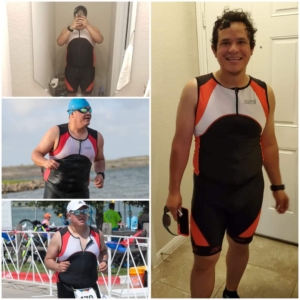
Maximiliano has gone from 255 lbs. (left) to 215 lbs. (right) since his first triathlon.
My name is Maximiliano Ramirez and my first son was born in February 2019. At that time I was in the worst physical shape of my life. I weighed 255 pounds and could not run more than two miles without getting exhausted. Seeing my son for the first time made me realize I had to make some changes to my life. That is when I got the crazy idea of participating in triathlons. With zero experience I bought my first used road bike online and registered for my first triathlon, Rookie Tri.
As you can imagine, I didn’t have much time to train (less than three months!). I was getting used to life as a father, but still managed to finish the race. But all I needed was that race to get hooked on triathlon. You can say I got the bug! I signed up for two more races that year, Lake Pflugerville Tri (Olympic distance) and Jack’s Genetic Tri. I was really pumped for the 2020 season, but as we all know Covid derailed events and training plans alike. During that time I was happy that I got an extra year to do more research. I learned more about training plans, different equipment, and how to take better care of myself. That gave me the courage to sign up for my first half distance triathlon at the 10th annual Kerrville Tri.
Continued support
When I made the decision to register for my first half distance triathlon, my wife, without hesitation, gave me her full support. Having her by my side throughout the training process has been incredible. I have researched many training plans and asked many of my friends for tips. I think asking for help is important to do. You never know what you’ll learn! Also, don’t be embarrassed to go out there and try something new, whether it’s new swim equipment or your longest bike ride.
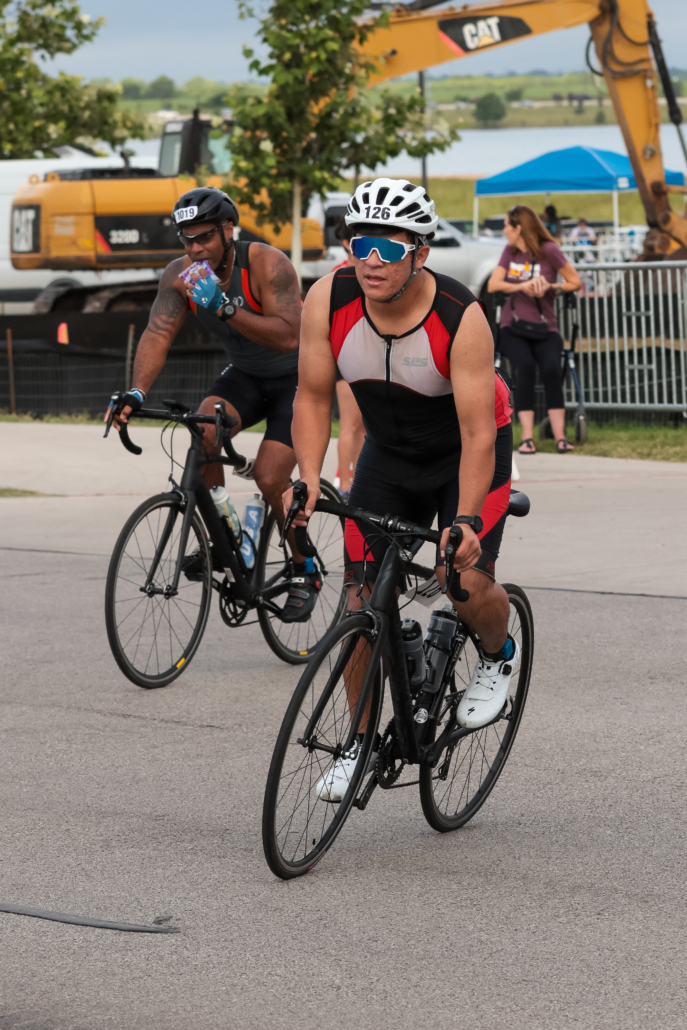
Maximiliano typically starts his long bike rides at 4:00 a.m.
My current training plan consists of two swimming days (Monday and Friday). That gives my legs time to recover before and after long weekend rides/runs. During the week I alternate between short runs and rides during my lunch break. Depending on how hectic my days are, there might be a day or two where I work out at night.
Tips to make training work
Like many other triathletes with families, work, and a busy life, finding time to train can be difficult. But really all you have to do is adjust your routine and schedule. For example, on my long rides, I typically go to sleep early so I can wake up around 4:00 a.m. This allows me to be out the door no later than 5:00 a.m. Making minor adjustments helps me balance training for my first half distance triathlon and everything else in my life.
In addition to the actual training plan, nutrition and hydration are just as important. Make sure to hydrate, especially with electrolytes, when training is demanding. I still consider myself a new triathlete and I’ve tried many products. Nothing has worked like I want just yet and I’ll continue to research and experiment until I find what works best for me. But just like training and certain workouts, you have to experiment with nutrition and hydration to discover what’s best for you.
I hope my experiences help others who want to register for a triathlon, but are nervous about jumping into something new. Just remember that anything is possible. You have to put in the work, but you should also be confident that you can achieve it. It will take time to get in a rhythm, but once you do it becomes second nature. Then you’ll graduate from sprint triathlons to your first half distance triathlon! I encourage everyone to join me at the 10th annual Kerrville Triathlon Festival. They have distances for triathletes of all abilities.
Grow as a swimmer when you transition from the pool to open water
The thought of swimming in open water can cause anxiety and feel overwhelming if you’re used to the clear waters of a pool. But don’t worry! It’s not as daunting as it seems. Transitioning from the pool to open water can be done easily by following some helpful tips. For example, if you want to become comfortable or more comfortable with open-water swimming, then you should swim in open water more often. Good news, all of our tips but one can be done in the pool! Start today and before you know it you’ll become more comfortable with taking your swim from the pool to open water. Pro tip: build your endurance in the open water with this Zone3 swim gear.
6 ways to become more comfortable
1) Keep your eyes closed
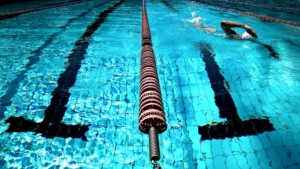
Close your eyes for a few strokes so you don’t focus on the line.
While swimming in the pool, keep your eyes closed for several strokes while your head faces down in the water. Increase the number of strokes as you become more comfortable. This will help you get a feel for swimming straight without needing to use the black line at the bottom of the pool as a reference.
2) Challenge yourself
This doesn’t have to be overwhelming, but there are a couple of different ways you can challenge yourself in the pool. First, try swimming in a pool that’s longer in length than what you currently train in. This will help build your stamina and get you used to swimming longer distances without stopping.
If you can’t access a longer pool, try moving your workout to earlier in the morning before the sunrises. This is beneficial if the pool isn’t lit and is similar to swimming with your eyes closed. Swimming when it’s darker outside can make it tougher to see. This provides an environment similar to what you’ll experience in open water.
3) Practice sighting
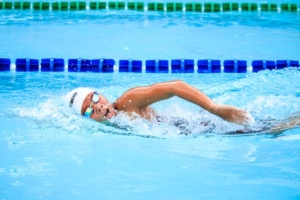
Get comfortable with sighting when you practice in the pool.
Sighting means you focus on something far away while swimming in open water. Focusing on that helps keep you from veering off course and swimming more than you have to. To practice sighting, you need to synchronize looking ahead with your stroke and breathing. Look at a target at the end of the lane, swim for two strokes, look at your target, repeat. This will help you become more comfortable with sighting in open water and keep you on course. Don’t swim extra if you don’t have to!
4) Learn to be efficient
In order to be an efficient swimmer, you need to reduce your stroke count for each lap. Sighting will help you become more efficient too. It takes fewer strokes and less energy if you swim in a straight line versus zig-zagging in the water. Taking in the right amount of oxygen when you breathe can help you become more efficient too. Keep your form the same as often as you can so you don’t over-extend yourself and feel like you have to play catch up.
5) Wear your wetsuit
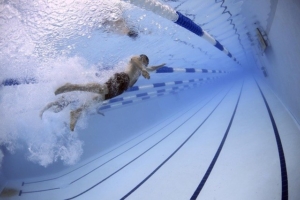
Focus on your form and breathing in the pool to become more efficient.
If you plan to wear a wetsuit during your event, you need to become familiar with it before race day. If you do this in the pool, know that chlorine can be harmful to your wetsuit. Wearing it before your race allows you to gauge the buoyancy of the wetsuit and its impact on your form and stroke. Learn about the pros and cons of wearing a wetsuit before you purchase one.
6) Swim in open water
This would be a great time to get familiar with your wetsuit! Find a lake or other body of water to practice swimming in open water. Doing this before race day will help you prepare for what you’ll experience. This is where all the work you’ve done in the pool gets used. You won’t have a black line to guide you, so sighting will be imperative so you can swim efficiently.
This advice will be beneficial in helping you transition from the pool to open water. As you practice in the pool, find what works for you and stick with it. Repetition in the pool is what will help you when you transition from the pool to open water. Ask other triathletes for their tips and advice, like advice on the best multisport watches. Who knows, the insight they provide might be useful for you.
Sighting Tips for Open Water Swimming
Swimming in the correct direction during open water can be a challenge for most athletes. This is why learning the proper technique for sighting in open water is crucial during training. Here are a few tips for sighting that can help when you line up for your next event.
Plan Ahead
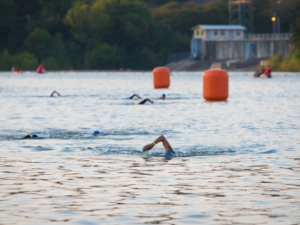
Print out the swim course map and go to the swim start to look for landmarks to use while sighting. Ideally, you want to survey the area at the same time when the swim will occur. This will give you an idea of where the sun is hitting the swim course and if the glare will be an issue.
Look for landmarks in the distance that are distinctive and easy to spot. Things like buildings, peaks of trees, or dips in the tree lines are great for spotting. Buoys can be hard to spot during the swim, and especially if you are slightly turned in the wrong direction, the significant landmarks provide an excellent alternative for sighting.
Come Up With a Game Plan
If the swim course runs parallel to the shores, use the shores to gauge if you are swimming in the correct direction. Look back towards the shore when you are taking a breath on your side while you are swimming. Also, use other swimmers to help you gauge if you are swimming in the correct direction. If you were swimming with a pack and suddenly found yourself swimming alone, popup and sight for landmarks or buoys to check if you are swimming in the right direction.
Prep Your Gear
Keep your goggles clean and apply your favorite anti-fog spray inside the goggles before the event. A good, clean pair of tri goggles will allow you to see better and further down the swim course to spot the swim buoys and landmarks.
Practice, Practice, Practice!
Here are some tips from seasoned triathlete and High Five Events‘ Operations Manager, John Chung. “Practice swimming with your head up in the pool. Use the cool down set for practice, and establish a rhythm for when to take a stroke for sighting. I like to swim two normal stokes and a sight stroke, pull, pull, sight. To get your head elevated slightly above water, push down instead of pulling through during the catch.
On your next open water swim practice, figure out which way you naturally curve to when you swim. For example, I tend to swim to my right, so if the buoys are on my left on a counter-clockwise swim course, I tend to swim away from the course. So for me, I need to look for buoys to my left when I sight during the swim. Sight 2 to 3 times to correct the direction in which you are swimming. First, locate the buoy or landmark you’ll use. Second, adjust your swimming direction to get back on course. Third, continue to sight as often as needed to make sure you are swimming towards the buoy or landmark.”
Make it a point to practice sighting during the cool-down portion of your swim sessions to have this skill mastered for your next event! Happy swimming!
Everything you need to know to find the best swim goggles for triathlon
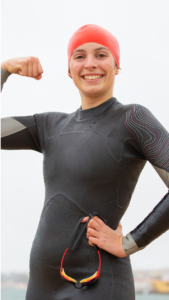
A good pair of goggles is a tri-gear essential that can make or break your swim during your big race. That’s why it’s critical to find a pair that meet your standards and needs. Durability, strength, comfortability, and adjustability are qualities you should look for before purchasing a new pair of tri goggles. Different kinds of goggles provide better protection, benefits, and effectiveness, depending on the type of swimming you’re doing. Get ready to race you best at your upcoming tri with our recommendations of the best triathlon swim goggles.
Here’s a couple of things to keep in mind before buying your pair:
Size Matters
The most notable difference between pool goggles and tri or open water goggles is tri goggles are bigger for a broader range of vision. This feature is critical to maximize your field of vision to properly sight while swimming for other athletes, buoys, and the almighty swim finish line. Tri goggles often come in various sizes, so make sure you get the pair that best fits your face without compromising your sight.
Pay Attention to Tint
Style may be important, but you don’t want to compromise style for function and vice versa. Tinted goggles may appeal to you more, but if you’re doing an open water race with muggy water, heavily tinted goggles would not be in your best interest. Plus, if you’re new to open water swimming, limiting your already hindered vision may be intimidating for most swimmers.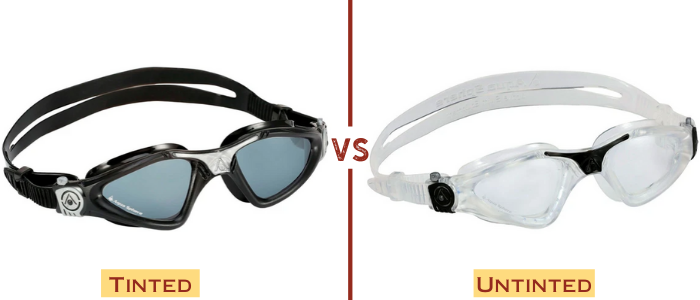
Train in the Goggles You Will Race In
This is the best way to avoid any race-morning mishaps from keeping you from performing your best on race day. Adjust your goggles to the exact tightness you’re comfortable with to prevent your goggles from filling up with water or even falling off mid-race. Pro Tip: Always have a second pair of goggles once you find a pair you like. It is always good to have on race morning in case something happens to your googles on site.
UV Protection
You protect your eyes during every other portion of the tri, and the swim is no exception. Most goggles typically have this feature, but double-check and make sure you get a pair with UV protection. The sun’s rays reflect off the water and make it hard to see, that’s why goggles with UV protection will shield your eyes from any damage and keep your vision manageable on sunny training or race days.
Check Out Our Top 5 Triathlon Goggles
- Long-lasting silicone straps
- Great anti-fog and
- Stylish
Speedo Covert Mirrored Swim Goggles
- Adjustable & comfortable
- Lightweight
- Wide-angle optical lens
- Maximum comfort with leak-resistant seal
- Low price, customizable and precise vision
- leak-resistant seal
Aqua Sphere Kayenne Swim Goggles
- Curved lens technology for 180 Vision
- Smoke lens
- Soft seals for extra comfort
AqtivAqua Wide View Swim Goggles
- 100% UV Protection
- No-slip double strap
- Great for indoor and outdoor swimming
You’re All Set!
Now you have all the tools you need to find the perfect pair of goggles to take you to the finish line at your upcoming tri! Didn’t see your fave goggles on this list? Want us to give them a try and add them to this list? Reach out on Facebook or Twitter and let us hear your thoughts!




